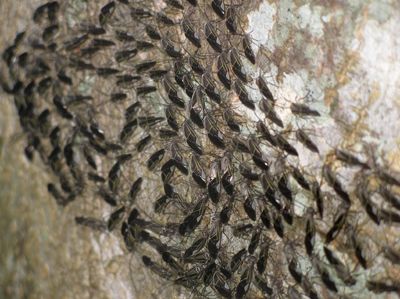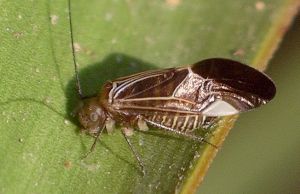
A whole mess of barklice - kind of creepy, isn't it?
The concept of groups vs. loners extends to the rest of the Animal Kingdom as well. However, in this case, we need to think in terms of species' survival needs rather than individuals' personal inclinations. It is easy to understand why large herbivores, such as zebra and deer, live in herds. There is safety in numbers and they all have enough to eat even if they are standing side by side. It's also obvious that predators, like weasels and hawks, must live in much smaller numbers. They can take care of themselves and their dietary resources are less abundant; too many of them and they wouldn't have enough food.
But now consider much smaller animals: the invertebrates and, in particular, insects. It is known that there are FAR more individual insects in the world than people. In fact, we are outnumbered by a factor much larger than I can imagine. We're surrounded by them, we step on thousands every time we walk on soil, they live in the air and the water, and, luckily for us, we don't usually notice them. When we think about the insects that we DO notice, we have already narrowed down our subject by quite a bit. Imagine if we were actually aware of every insect within, say, ten feet of us. The effect of those numbers would be, to say the least, a bit overwhelming. We'd realize that we are not only vastly outnumbered, but it would be by creatures so alien to us that they appear as if from another planet. That is not comforting.
 A whole mess of barklice - kind of creepy, isn't it? |
Although we are bigger than insects, they are not helpless and have a number of ways to protect themselves. Those that sting or bite tend to grab our attention more than those that flee or rely on camouflage. Whether we want to or not, each and every one of us knows at least a little bit about insects. A problem arises, though, because that knowledge is often VERY little, to the point of being next to nothing. The thing we tend to fear the most is the unknown and, for many folks, insects present a substantial unknown.
Once an animal, even an insect, is more familiar and understood, it usually becomes much less frightening. Almost nobody is afraid of a butterfly. They are familiar, and even pretty. There are some people, though, that are anxious about moths. A butterfly cannot hurt a person, but some will actually attack (they just ram your head with their body). No moth acts territorial like that, and yet moths, being less familiar, as well as creatures of the night, are the ones that cause distress in a small subset of humans.
One of the ways that insects make us uneasy is that they come in vast numbers. We all know that ants and termites are social and often have colonies numbering in the thousands. A trail of ants seen crossing a sidewalk rarely upsets anyone. But finding a piece of leftover biscuit on our kitchen counter covered with ants IS disconcerting. If there were just one or two ants, even in the sanctity of our home, we'd just squish them and think nothing of it. But when we're confronted by several hundred, it's a whole different matter. We're outnumbered, and we don't like it.
I frequently find insects outdoors and often watch what they are doing. I'm used to which species are common and which are not, as well as which ones are found in large groups and which are solitary. It is always startling to find a group of insects together that don't normally live that way. I expect to find aphids coating a plant, but when stink bugs are clustered so thick that they conceal the underlying vegetation, well, that gives me a bit of a jolt. Of course, if I have never seen a particular insect, I might not know its lifestyle preferences.
 A single barklouse - now that's not so bad! |
It didn't take long to discover that these odd little insects were barklice, members of a small family of no economic or medical consequence to people or their crops and so usually completely ignored. These small bugs are among the vast majority of insects - they are not pests and just go about their lives in an unobtrusive manner. Barklice feed on algae and fungus on the bark of trees. That's it. They don't hurt anything and even do a bit of cleaning to boot.
The difference between my initial reaction and my opinion following that bit of research was like night and day. The insects were no longer gross and a bit scary, but sort of elegant and interesting. Still, the fact that there were a lot together was one more hurdle to overcome before I felt relaxed about the encounter. The negative reaction to large numbers of insects is probably rooted deep in our prehistoric past, when encountering a vast swarm of hornets or watching a horde of millions of locusts denude all the vegetation in an area was truly a matter that affected our survival. Our ancient ancestors automatically understood that a single bug is okay, but a whole lot together is just plain creepy!